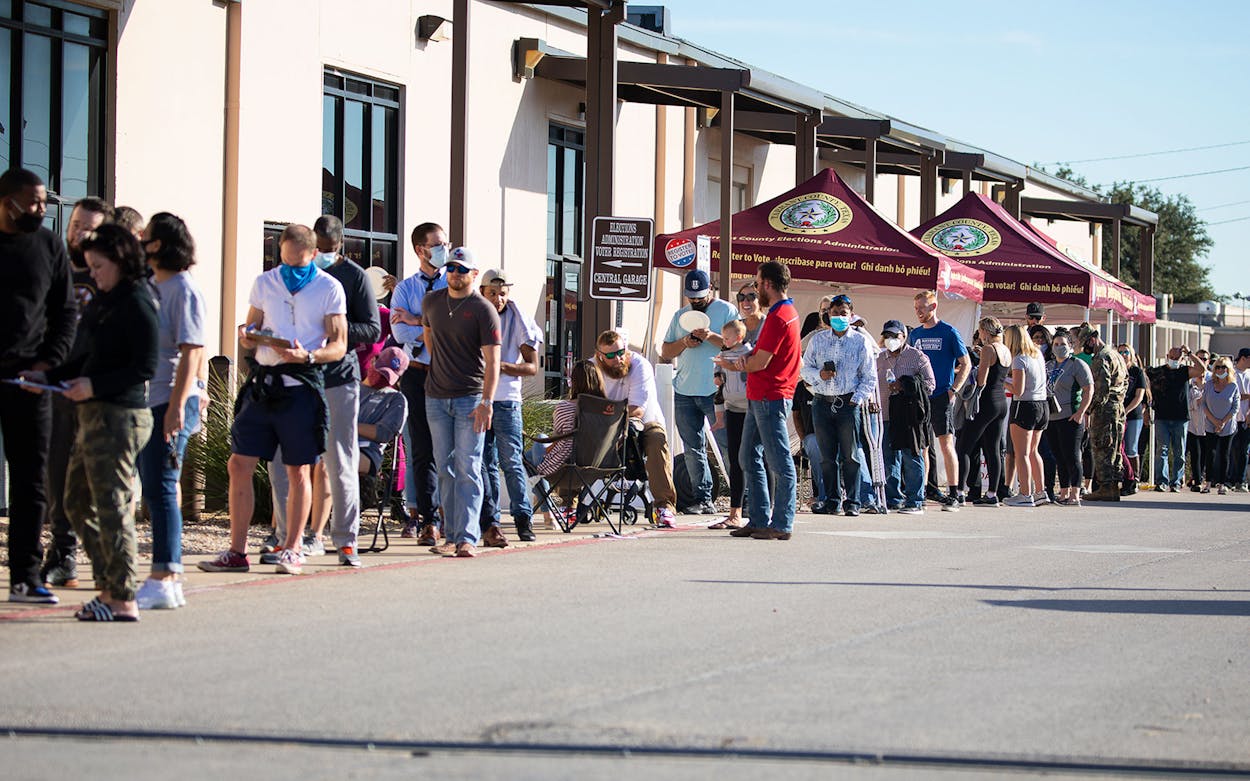On Thursday evening, Texas entered uncharted territory: the state surpassed its previous voter turnout record a full 24 hours before the pandemic-extended early balloting period had even ended, and five days before Election Day. By the time early voting concluded on Friday, 9.7 million Texans had voted, far surpassing the 8.97 million who cast ballots in the 2016 presidential election.
How will the turnout spike influence results? Let’s take a look at what we know—and don’t—just before Election Day.
How Many Texans Are Left to Vote?
Texas has seen the biggest increase of any state in the percentage of voters casting ballots in 2020 so far. That’s good for bragging rights, but it also makes a big difference in how the election might play out.
In 2016, Donald Trump beat Hillary Clinton in Texas by 807,179 votes, a 9-point margin. Polling suggests that the vast majority of Texans who voted for Trump in 2016 are likely to stick with their man, and those who voted for Clinton will vote again for a Democrat. So the key to victory will be who wins among 2020 voters who didn’t cast ballots in 2016, either because they weren’t motivated, weren’t old enough to vote, or hadn’t moved here yet. The percentage of such voters Joe Biden needs to win changes dramatically based on the turnout. If 10 million Texans cast ballots in 2020, then the former vice president needs to win new voters by a massive 40-point margin. If 12 million cast ballots, he only needs to win those voters by a 62–38 margin, which is more in line with his campaign’s polling among Texas voters who didn’t vote for either 2016 candidate.
The difficulties of predicting turnout in an unprecedented situation hasn’t stopped a number of electoral observers from making guesses.
12 million, buddy. Bet you a Shiner https://t.co/mhzLB5GcYb
— Evan Smith (@evanasmith) October 30, 2020
It's quite possible Texas will cast more than 12 million votes in this election. That would be a massive increase after 8.96 million votes cast in 2016 and 8.37 million cast in 2018.
— Dave Wasserman (@Redistrict) October 31, 2020
Political science fellow @MarkPJonesTX expects #ElectionDay totals to push #Texas' final vote count further into record breaking territory — as high as 12 or 12.5 million. #Elections #Elections2020 #TX2020 #VOTE https://t.co/Vtlv3VX1Gc
— Baker Institute (@BakerInstitute) November 2, 2020
To get to 12 million ballots cast, Texas needs roughly 2.3 million Election Day voters. As political data consultant Derek Ryan noted in his early vote analysis newsletter this weekend, among registered voters who haven’t yet cast a ballot, there are 3.1 million Texans who have voted in previous presidential elections, and 4.2 million with no election history in Texas. If just three quarters of the first group show up on Election Day—which Ryan projects has a good chance of happening—the state would hit 12 million voters. And if 10 percent of the second group turn out as well, that would get the state to 12.5 million voters.
What Does This Year’s High Turnout Mean for Down-Ballot Races?
Over the past four years, Texas’s urban and suburban areas have trended in favor of the Democratic party, while its rural communities remain a deeply conservative bulwark. In 2018, the rural areas, which Ted Cruz won by nearly 50 points, kept him in the Senate, despite his challenger Beto O’Rourke winning the state’s six biggest counties by 23 points. In suburban Texas, O’Rourke’s winning margins indicated that several heavily gerrymandered congressional districts were suddenly competitive. (Democrats managed to flip two of them in 2018, the Houston-area TX-7 and the Dallas-based TX-32.)
This year, early turnout was healthy in many of the state’s rural counties but it hasn’t matched 2016 totals. The state’s historic turnout this year has been driven by urban and suburban voters. Each of the most populous counties in Texas—Harris (Houston), Dallas, Tarrant (Fort Worth), Travis (Austin), and Bexar (San Antonio)—surpassed their 2016 turnout by the end of early voting. Suburban counties including Denton and Collin (Dallas–Fort Worth), Fort Bend (Houston), Williamson (Austin), and Hays (between Austin and San Antonio) experienced the largest turnout increase across the state, all surpassing their 2016 totals by more than 25 percent.
Of course, we still don’t know for whom all of those new voters are casting ballots. But broadly speaking, Democrats are excited about increased participation in Texas, while Republicans have taken numerous actions to make voting more difficult. Historically, increased turnout has meant tightened margins in districts that were constructed to favor Republicans.
Does This Mean Texas Will Go Blue?
Democrats hope new suburban voters are going to flip as many as ten congressional races, elect a Democrat to the Senate for the first time since Lloyd Bentsen won his last race in 1988, and deliver 38 electoral votes to Biden. The more new voters turn out, the more realistic that hope becomes. But we’ve heard the prediction that Texas will turn blue for several elections now, and some skepticism is probably in order.
As Ryan’s analysis of the early vote notes, roughly 45 percent of Texas’s early voters hadn’t previously cast a ballot in either party’s primary, which makes it especially hard to predict who they might have voted for. Might there be a slew of Trump supporters in the suburbs who either sat out the 2018 midterms or registered to vote after seeing Democrats come so close to capturing a U.S. Senate seat in the state? Might the influx of newcomers to Texas from states such as California have included many conservatives looking to live in a red state? Might the 1.8 million registered voters Texas has added since 2016 lean toward one party over the other? We won’t know until all the votes are counted.
- More About:
- Politics & Policy








